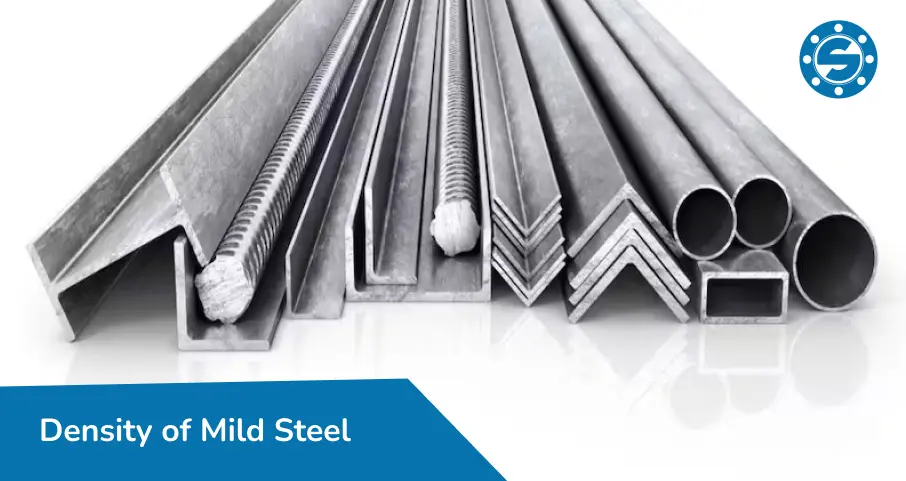Density of Mild Steel

Mild steel, or low-carbon steel, is one of the most commonly used types of steel due to its versatility and affordability. It’s widely utilized in construction, automotive manufacturing, fencing, and signage, among other applications. Mild steel is known for its good weldability, machinability, and ductility, making it an ideal choice for various projects.
This steel is primarily defined by its low carbon content, typically less than 0.2% by weight. The AISI (American Iron and Steel Institute) classification codes for mild steel begin with “10” and are followed by two digits representing the carbon content in hundredths. For example, a code ending in “15” indicates a carbon content of approximately 0.15%.
This article will delve into the chemical composition, mechanical properties, grades, and key characteristics of mild steel, providing a comprehensive understanding of this widely used material.
What is Mild Steel?
Mild steel, also known as low-carbon steel, is a type of carbon steel that contains a low level of carbon—typically between 0.05% to 0.25% by weight. In contrast, high-carbon steels have carbon content ranging from 0.30% to 2.0%, and any higher carbon content would classify the material as cast iron.
Unlike alloy steels, mild stee l does not have significant amounts of elements like chromium or molybdenum. The lower carbon content gives mild steel certain characteristics that distinguish it from higher carbon and alloy steels. For instance, mild steel is more ductile, machinable, and weldable. However, its lower carbon content also makes it less capable of being hardened or strengthened through heat treatment processes like quenching.
The structure of mild steel, which contains a high amount of iron and ferrite, also makes it magnetic. However, the absence of protective alloying elements, such as those found in stainless steel, leaves mild steel susceptible to rust if not properly coated.
Despite these drawbacks, mild steel remains a popular choice due to its affordability, ease of welding, and machinability, making it suitable for a wide range of applications, from construction to automotive use.
Density of Mild Steel in kg/m³, g/cm³, lb/in³
Mild steel has a density of 7.85 g/cm³, 7860 kg/m³, or 0.284 lb/in³. This consistent density is largely due to its composition, which is primarily over 98% iron, with small amounts of carbon, manganese, and silicon. Since iron, with a density of 7.87 g/cm³, makes up the bulk of mild steel, it significantly influences its overall density. Mild steel alloys that include minor amounts of other elements may have slightly different densities, but the variation is usually minimal.
What is the Composition of Mild Steel?
What Are the Different Grades of Mild Steel?
| Classification | Approximate Equivalents | Key Points |
|---|---|---|
|
Classification
AISI 1008 |
Approximate Equivalents
DIN 1.0204 |
Key Points
Excellent cold formability |
|
Classification
AISI 1010 |
Approximate Equivalents
DIN 1.0301 |
Key Points
Low strength, used for magnet cores |
|
Classification
AISI 1015 |
Approximate Equivalents
DIN 1.0401 |
Key Points
Wear-resistant, good machinability |
|
Classification
AISI 1018 |
Approximate Equivalents
DIN 1.0419 |
Key Points
Excellent for carburizing applications, good machinability |
|
Classification
AISI 1020 |
Approximate Equivalents
DIN 1.0044 |
Key Points
A good balance of strength and ductility, |
Mechanical Properties of Mild Steel
| Type of Mild Steel | Modulus of Elasticity (GPa) | Brinell Hardness | Ultimate Tensile Strength (MPa) | Yield Strength (MPa) | Elongation at Break (%) | Steel Density kg/m3 |
|---|---|---|---|---|---|---|
|
AISI 1008 |
200 |
95 |
340 |
285 |
20 |
7.87 |
|
AISI 1010 |
205 |
105 |
365 |
305 |
20 |
7.87 |
|
AISI 1015 |
205 |
111 |
385 |
325 |
18 |
7.87 |
|
AISI 1018 |
205 |
126 |
440 |
370 |
15 |
7.87 |
|
AISI 1020 |
186 |
121 |
420 |
350 |
15 |
7.87 |
|
S275 J0 |
205 |
121 |
430 – 580 |
275 |
21 |
7.85 |
|
S355 J0 |
210 |
146 |
510 – 680 |
355 |
20 |
7.80 |
Mild Steel Chemical Composition
| Classification | Carbon Content (% Weight) | Secondary Alloying Elements (% Weight) |
|---|---|---|
|
AISI 1008
|
<0.1
|
0.3 to 0.5 Mn; 0.04 P; 0.05 S
|
|
AISI 1010
|
0.08 to 0.13
|
0.3 to 0.6 Mn; 0.04 P; 0.05 S
|
|
AISI 1015
|
0.13 to 0.18
|
0.3 to 0.6 Mn; 0.04 P; 0.05 S
|
|
AISI 1018
|
0.14 to 0.2
|
0.6 to 0.9 Mn; 0.04 P; 0.05 S
|
|
AISI 1020
|
0.17 to 0.23
|
0.3 to 0.6 Mn; 0.04 P; 0.05 S
|
|
S275
|
0.18
|
1.5 Mn; 0.030 P; 0.030 S; 0.012 N; 0.55 Cu
|
|
S355
|
0.2
|
1.6 Mn; 0.030 P; 0.030 S; 0.012 N; 0.55 Cu
|
Industrial Applications of Mild Steel
Mild steel is a versatile material widely used across various industries. Common applications include car bodies, furniture, wire, rebar, and fasteners. Its higher-strength variants are often employed in structural work and storage tank plating, making it a go-to choice for both everyday products and more demanding industrial uses.
Here are some examples of where it is used in the world-
- Structural steel
- Signs
- Automobiles
- Furniture
- Decorations
- Wire
- Fencing
- Nails
The Carbon Content in Mild Steel
What Is the Toughness of MS Steel?
5. Thermal Expansion:
What is Mild Steel’s High Melting Point?
Is Mild Steel Suitable for Welding?
Summary
This blog provided an overview of mild steel, including its definition, main properties, and different grades. For further details or any inquiries about mild steel, feel free to contact a representative at Solitaire Steel.


